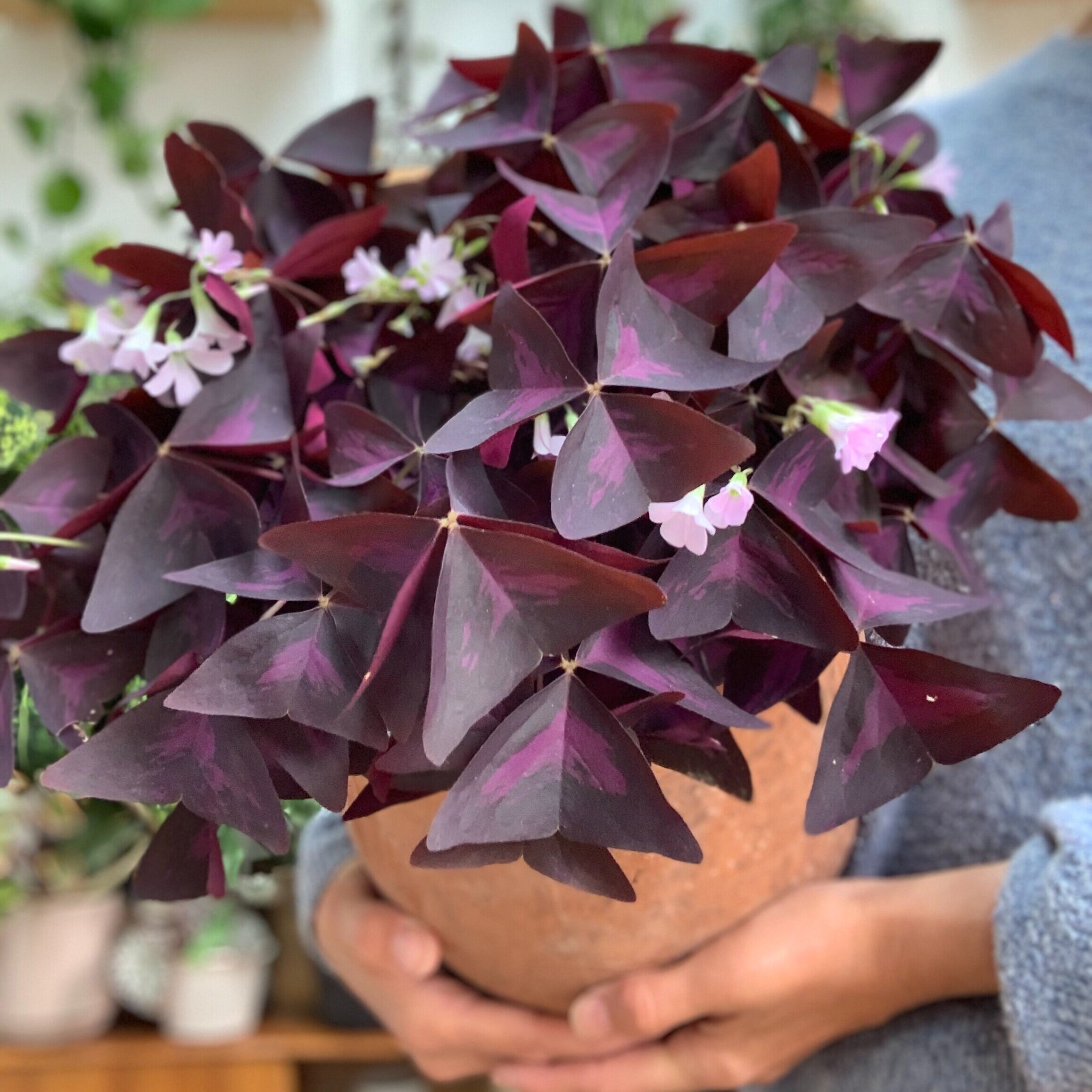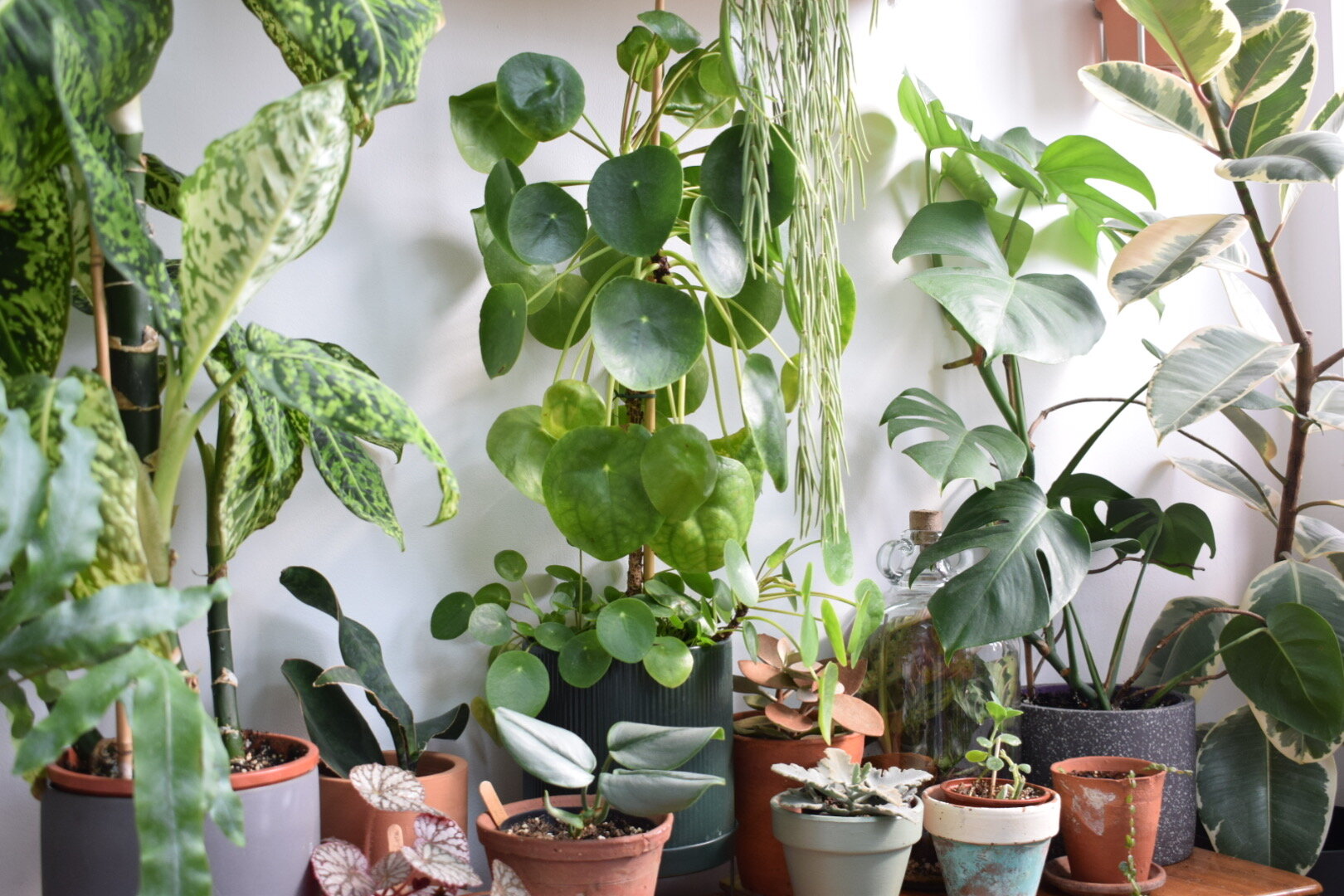There’s not much to love about lockdown, but one positive is certainly the amount of new plant parents there are out there now! With that in mind we’ve created an ultimate go-to guide for anyone new to the houseplant life.
Read on for top plant care tips, ideal plants for first timers and much more…
General considerations for houseplant ownership
Understanding the amount of light in your home:
Knowing how much light each area gets is vital to knowing which plants will do well in that area. Most plants will be described as needing direct light, indirect light or low light. This can be a bit confusing so we have explained them in more detail here…
Direct light definition: an area in bright sunshine. A south facing window will receive the longest periods of direct sunshine in a day. An east or west facing windowsill will receive a shorter period of direct sun each day.
Indirect light definition: a bright area where there is no direct sunshine reaching the plants. E.g a couple of meters back from a south facing window or near to an east or west facing window. A south-facing window that is frosted or has a filtering blind will also give bright indirect light.
Low light definition: usually close to a north facing window, or near an east or west facing area window that has a slightly restricted view of the sky. Note, no plant can survive for long with no natural light. If you want to have plants in a room with no windows or a dark corner we would suggest using grow lights. Discover the grow lights that major house plant fanatics recommend here.
Research a houseplant’s needs before you buy it:
You might fall in love with the look of a plant, but be sure to research the light, water and soil requirements needed for the plant to thrive. Can you provide that environment and care for the plant?
Get to know the natural habitat of your houseplants:
Understanding how plants thrive in the wild is the best clue to how they should be treated in our homes. Are they naturally forest floor plants wanting a damp, shadier spot with rich soil? Or are they desert dwellers used to lots of sunshine, little rainfall and low nutrient soil?
We suggest researching your plants’ natural habitat and mimicking it as much as possible with corresponding potting soil, light, water, nutrients and heat.
Where to buy plants:
We would always recommend buying plants from independent plant shops or garden centres, online or in person, rather than the supermarkets. Plants from the smaller independent shops will generally be better quality, be better looked after, have less risk of pests, and you will have more access to advice. You can use our Plant Shop Directory to find our recommended plant shops and garden centres near you.
How much time do you have to give your houseplants?
It’s very easy to get bitten by the houseplant bug and want to fill your home with plants, but do you have the time to care for them in the way they need?
If you have little time then consider getting plants that seem to thrive on neglect rather than those that are known to be fussy.
If you like to go away a lot (remind us what that feels like?!) then think about how your plants will be cared for when you are away.
Read on for a list of plants to suit your lifestyle.
Top houseplant care tips
We think one of the best things about owning plants is how much there is to learn along the way, these top tips should be a good starting point…
Ensure plant pots have drainage holes:
Many a plant meets its premature end due to the roots sitting in water for prolonged periods. Make sure plant pots have drainage holes to let water drain out fully. A good idea is to have your plant in a nursery pot (generally a plastic one that you will have bought the plant in) and place that within a decorative pot with no drainage holes. When you water, take the plant out of the decorative pot and water the plant in the sink ensuring all water has drained away before placing it back in the decorative pot.
Less is more when it comes to watering:
The most common cause of plant death is over watering and it is far harder to revive an over-watered plant compared to an under-watered one.
Many houseplants such as Monstera, Pothos, Ficus will only want to be watered when the top inch of soil is dry, put your finger into the pot to test this. Other houseplants like the soil to be evenly moist such as Ferns, Fittonia, Maranta and Coleus.
The best advice is to understand a plant’s water requirements and also to look to the plant for clues that it needs watering; often the leaves will look less plump, go wrinkly, or start to go floppy when they need a drink.
It’s a good idea to water your plants from the bottom, this means sitting your plants in water and letting them soak up what they need. We find it best to let them soak until you see the soil surface has dampened just slightly. (This is minutes rather than hours.) Note, some plants should always be watered from the bottom such as Begonia rex because water on their leaves can cause fatal mould and Blue Star Ferns as new growth comes from rhizomes (chunky and hairy stems) growing on top of the soil, which shouldn’t get too wet.
Simple maintenance goes a long way:
Don’t be alarmed by the odd yellow or brown leaf, generally the lower leaves on a plant can yellow just due to natural ageing. Chop these off and give the healthy leaves a wipe to keep them free of dust, this will help the plant to maximise the sunlight and produce as much energy as possible.
In the spring and summer months give plants an extra boost by feeding them every couple of weeks. We love Liquid Gold Leaf. We also hear great things about Baby Bio.
Wipe the leaves regularly to keep them free of dust, this will ensure maximum light intake for the plant.
Avoid draughts and radiators:
No houseplant will like to be placed either in a draught or near to a radiator. The fluctuation in temperature and rapid air flow causes stress to the plant and plays havoc with the plant’s natural ability to regulate its natural rate of water evaporation.
Raising humidity for houseplant happiness:
You will read that many houseplants like lots of humidity, remember many houseplants are native to tropical rainforests where the conditions are warm and humid. Calathea in particular like lots of humidity so can be a tricky variety to thrive in our dry central-heated homes. Here are some ways that you can raise humidity:
Bathrooms (if they have a decent amount of indirect light) will be a good place for plants who like more humid conditions.
A humidifier placed next to plants can provide that boost they need and increase the ambient humidity around the plants.
Placing a plant pot on a tray of pebbles and water will help to increase humidity around that plant as the water in the tray evaporates. Note, ensure the plant is not sitting directly in the water, but on the pebbles above the water level, this is to avoid root rot.
Misting will do little to increase the ambient humidity around a plant, you would need to mist several times a day to make any real difference to the humidity.
Check for pests:
Always check for pests on your new plants (especially if you have brought from a supermarket). It is a good idea to keep any new plants separate from others in your house for a coupe of weeks at least, and regularly check for pests to make sure they are all pest-free before introducing them to the rest of your collection.
You can check our common houseplant pest guide here for how to spot the pesky creatures.
We would also recommend spraying new plants once a week with the following solution. In a 500ml spray bottle of water add 2.5ml of neem oil, and a small squirt of washing up liquid. This will act as a preventative measure against pests.
Choosing the best plants for you
Here are our top plants for different environments and lifestyles…
Easy care houseplants for beginners:
ZZ plant, Sansevieria, Pothos (Scindapsus) varieties, Monstera deliciosa, Ceropegia woodii (String of hearts)
Houseplants for beginners that you might not have thought of:
Chinese Money Plant (Pilea peperomioides), Rhaphidophora tetrasperma, Fishbone Cactus (Epiphyllum anguliger), Hoya linearis, Oxalis Triangularis, Phildendron micans
Houseplants for the neglectful:
Cacti, Sansevieria, Ceropegia woodii (String of hearts), Ficus elastica, closed Terrarium, Aspidistra, ZZ plant
Non-toxic houseplants for those with pets or children:
Calathea, Fittonia, Pilea peperomioides, Chlorophytum comosum (spider plant), Kentia palm
Houseplants for easy propagation:
Spider plant, Pilea peperomioides, Philodendron scandens, Pothos varieties, Monstera adansonii, Fishbone cactus, String of hearts, Echeveria
(See step-by-step propagation techniques here).
Houseplants for low light:
Aspidistra, Sansevieria, ZZ plant, Calathea, Ferns, Scindapsus pictus (Sating Pothos), Philodendron scandens, Dracena, Aglomena, Polyscias Fabian
Houseplants for direct light:
Cacti, some Echeveria, Jade plant, Sago palm, Aloe, Euphorbia ingens
Fussiest houseplants for those wanting a challenge:
Alocasia zebrina, Calathea orbifolia, Maidenhair fern, Fiddle leaf fig
Fast growing houseplants for the impatient:
Rhaphidophora tetrasperma, Golden pothos, Ficus elastica, Philodendron scandens, Philodendron micans, Tradescantia, Monstera adansonii
Simple houseplant propagation
One of the biggest joys of keeping houseplants is propagating them to create new plants for free.
There are a variety of methods for propagating and all are fun to try. Different plants will propagate best in different ways.
Take a look here for really easy step-by-step propagation techniques.
Common houseplant pests and treatments
Even the most doting of houseplant lovers is unfortunately likely to experience pests on their beloved collection at some point, so we’ve put together a rundown of the most common houseplant pests with tried and tested treatments. Learn how to spot, treat and prevent Fungus gnats, Mealy bugs, Thrips and Spider mites here.
Caring for houseplants in Winter
With low light levels, temperature fluctuations and natural dormancy winter can be a trying time for houseplants. We’ve collated the best tips and tricks for ensuring your houseplants stay happy over the winter months here.
Repotting houseplants; why, when and how?
Why repot houseplants?
As plants grow they will outgrow the pot they are in and will need to be moved into a bigger pot. Repotting gives the plant’s roots more room to grow and more access to nutrients to aid the plants health and growth.
When to repot houseplants:
The best time to repot is in the spring when the plant is not stressed by the colder winter months and to give it the extra boost it needs for the growing season ahead. You will know that a houseplant is ready to be repotted when you can see roots growing out of the drainage holes in the bottom of the pot. You could also gently slip the plant out of its pot to take a good look at the root system. If the roots are filling the pot leaving little soil and are growing in a circle around and around the pot then it is time to repot.
Potting mixes:
It might not be the most glamorous aspect of plant collecting, but giving your plants the right type of soil is a vital aspect of houseplant happiness. We’ve created three easy to reference explanations of potting soil for different plant types:
Coming soon: guest botanist Kathleen Groves gives us her fail safe potting mixes
How to repot houseplants:
Houseplants should be repotted into a pot that is one size up from the current pot. Before you start, get prepared with a decent space to do your repotting, covering the surface to make it easier to clean up any spilt soil when you have finished and get together your plant, new pot and new potting mix.
First, put an inch or two of your new potting mix into the new pot.
Next, gently squeeze the plastic nursery pot and hold the plant upside down giving it a gentle tug to release the plant from the pot.
If possible give the roots a little tease so they are not compacted together. You may want to tease out old soil and also cut off any black, shrivelled or mushy roots.
Now gently place the plant into the new pot checking that the base of the stem is at the right height; a cm or two from the top of the pot.
When you are happy with positioning in the new pot fill in around the plant with your new potting mix.
Give the new pot a gentle tap or two down on the table to ensure soil is reaching all areas around the roots.
Press the soil at the base of the plant gently to really settle the plant in place and you’re done.
Finally give the plant a good water and admire your work!
Help! What is wrong with my plant?!
We hope this guide helps to keep your houseplants happy, however when your plant isn’t looking so healthy you can check for the following issues:
Signs of an over-watered plant:
A limp, floppy plant with soft almost mushy stems
Several yellow leaves often with dark brown patches
A white mould to the top of the soil
What to do next:
You can chop of any of the stems and leaves that look completely unrecoverable
Take the plant out of its pot and remove as much soil from around the roots as possible.
If the roots look black, cut them off, if there are roots that are lighter in colour or ideally white there is hope for your plant!
Repot the plant using the correct potting mix mentioned above, into a pot with drainage holes.
Keep a close on the plant for signs of recovery, in general only water when the top inch or more is dry.
Signs of an under-watered plant:
A wilted plant
Curled leaves
Dry, crispy edges to the leaves
Very dry soil that has shrunk away from the sides of the pot
What to do next:
Take your plant out of its decorative pot and to the sink
Give the plant a good drenching with water
Ensure all the water has drained away before placing the plant back in its decorative pot
Cut off any dead dried leaves
You can also cut off any dried tips or edges to the leaves
Signs a plant is not getting enough light:
Slow growth
Sparse leaves on elongated stems
Yellowing leaves
What to do next:
Move your plant into a lighter area
Add a grow light if you do not have a brighter spot
Rotate plants regularly to ensure all sides are getting enough light
Signs a plant is getting too much light:
Dry, crisp edges to the leaves (you might also need to increase the humidity)
Scorched looking leaves
Wilted, drooping leaves
Yellowing of leaves from the outer edge
A plant may lose leaves
Plant wilts very quickly after recently being watered (a slightly bigger pot may also help with this as the soil will not dry out so quickly).
What to do next:
Move the plant to a less bright spot, or a spot with fewer hours of bright light
Consider using a filtering blind at the window to shield the plant from the most intense light
Signs of pest damage:
There are many ways in which pests can cause damage to plants, it may be that you can spot the bugs themselves like fungus gnats or white mealybugs, or it may be the damage of spidermites is visible before you even notice the tiny pests.
Have a read of our Common Houseplant Pests blog to help you identity different pests and how to treat them.
Useful resources for houseplant care
The Houseplant Expert by Dr. D. G. Hessayon
Root Nurture Grow by Studio RoCo
On The Ledge podcast by Jane Perrone
The RHS website
HOUSEPLANTHOUSE blog by Dr. Laura Jenkins
UK Houseplants website by Joe Bagley
We hope this guide proves useful and sets you on the way for a long and happy love affair with houseplants! Visit our blog for much more on expert plant care, inspiration and how-to guides.
















































